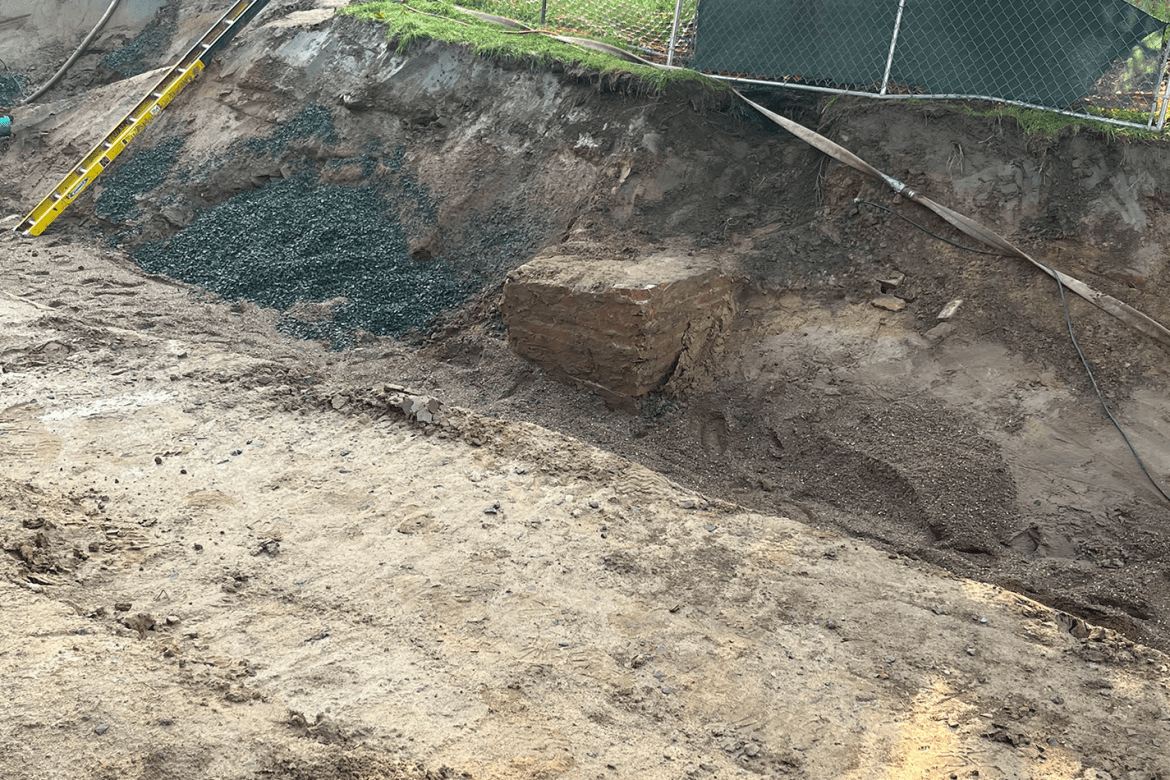A glimpse of the College’s nineteenth-century centerpiece

Construction for Mount Holyoke’s new geothermal energy project led to discoveries from the College’s beginnings.
In late June, Karla Youngblood FP’99 got a phone call she’d been hoping to receive. The contractor overseeing work for the campus’s newly launched geothermal energy project had some news. Workers discovered part of an historic brick foundation wall five feet below ground level while digging a large trench about 60 feet from the entrance to Abbey Memorial Chapel.
Youngblood, the College’s associate vice president for facilities management, instantly knew what it was. Before excavation work started, she had been alerted by colleagues at the Mount Holyoke College Art Museum that the foundation of the College’s original building — the massive Seminary Building dating back to Mount Holyoke’s founding year of 1837 — could soon see the light of day.
Upon close inspection of the discovery, Youngblood realized she was looking at firebricks. Less porous than common bricks, firebricks are exceptionally heat resistant and still used to line fireplaces, furnaces and boiler rooms. “They look exactly the same,” she said. “In fact, we have similar firebricks in the campus’s gas-fired boiler rooms today.”
But on the tragic day of September 27, 1896, when a fire broke out in the Seminary Building, coal was king. The massive four-story structure, where Mount Holyoke students spent almost all of their time — sleeping, eating, studying and exercising — was heated by a coal-fired steam boiler system. Geothermal project workers, gingerly digging with hand tools to avoid disturbing the brickwork, discovered the base of the coal-burning boiler room at the rear southeastern corner of the Seminary Building. Its grand facade, featuring a two-story piazza, stood over College Street roughly between where the Williston Library and chapel buildings stand today.
The fire completely destroyed the Seminary Building, leaving nothing standing but shards of exterior brick walls. Miraculously, no one was injured or killed — but overnight, the heart of the College’s campus had almost vanished.
From seminary to (carbon-neutral) college
Forget about today’s campus spread across more than 700 acres for a moment. Imagine instead one rectangular brick building, 94-feet wide and 50-feet deep, looming over young elm trees and neighboring houses in the small village of South Hadley. This was the scene in 1837, when the first students arrived in November. The Seminary Building essentially was the institution, then called Mount Holyoke Female Seminary. (In the nineteenth century, the word “seminary” didn’t have today’s strong theological connotations; it could be used to describe college preparatory, college-level, graduate or professional training schools.)
“The building served all purposes,” said Deborah Richards, Mount Holyoke College’s head of Archives and Special Collections. It featured a dormitory, teachers’ residence, laundry room, classrooms, gymnasium, business office, elevator, dining hall and kitchen (in the basement) and power plant. Founder Mary Lyon and her successors, along with all students, lived in the building. “It grew and developed as the seminary grew and changed,” Richards said.
By 1896, when tragedy struck, a succession of additions (including the coal power plant built in 1865) turned the initial rectangular building into a much larger squarish structure enclosing a four-sided courtyard.
“It was a highly structured, very close-knit community of students and their teachers,” Richards said. Students helped with cooking and cleaning their rooms. There was no housekeeping staff. “It was very much a community of young women living with their female teachers.”
Although the fire was devastating, the school — which in 1893 changed its name to Mount Holyoke College — did not close for rebuilding. Instead, local residents housed students, and classes were held in the library building, which firefighters managed to save.
“We learned … that all the townspeople were our friends,” President Elizabeth Storrs Mead wrote in a report to College trustees. “They opened their doors to the homeless, and … every student was provided with shelter for the night.”
What emerged from the ashes of disaster was a commitment to build a new and stronger College through a newly envisioned campus. “It was a fresh start for the College to reimagine how it wanted to be a college,” Richards said. “They had the opportunity to rethink what campus could be.”
In the months and years following the fire, land was acquired, and a new landscape began taking shape, with separate buildings for dormitories, administration, a gymnasium and classes. A modern campus was born.
Yet even as dramatic changes transformed the campus between 1896 and 2023, portions of the Seminary foundation sat undisturbed just a few feet underground. (Contract workers also found common bricks, a few small glass bottles and pieces of pottery.) A few of the bricks discovered in June will be permanently preserved by Richard’s Archives and Special Collections team.
“Being able to hold something substantial from the actual building — it’s very exciting,” Richards said.
Newly discovered bricks have also been presented to President Danielle R. Holley, tangibly connecting the newly inaugurated leader to the College’s earliest days. “That’s pretty special,” Youngblood said.
Also noteworthy, she added, is the fact that part of campus’s original fossil fuel–burning infrastructure was found while laying the groundwork for “state-of-the-art heating technology.” The multiphase geothermal energy project, which began this year and is scheduled to be completed in 2030, is a top priority of President Holley’s and a key step toward becoming carbon neutral by 2037, the College’s bicentennial.
“The campus continues to evolve,” said Youngblood, noting that the discovery of the firebricks and other artifacts hasn’t affected the geothermal project’s schedule.
